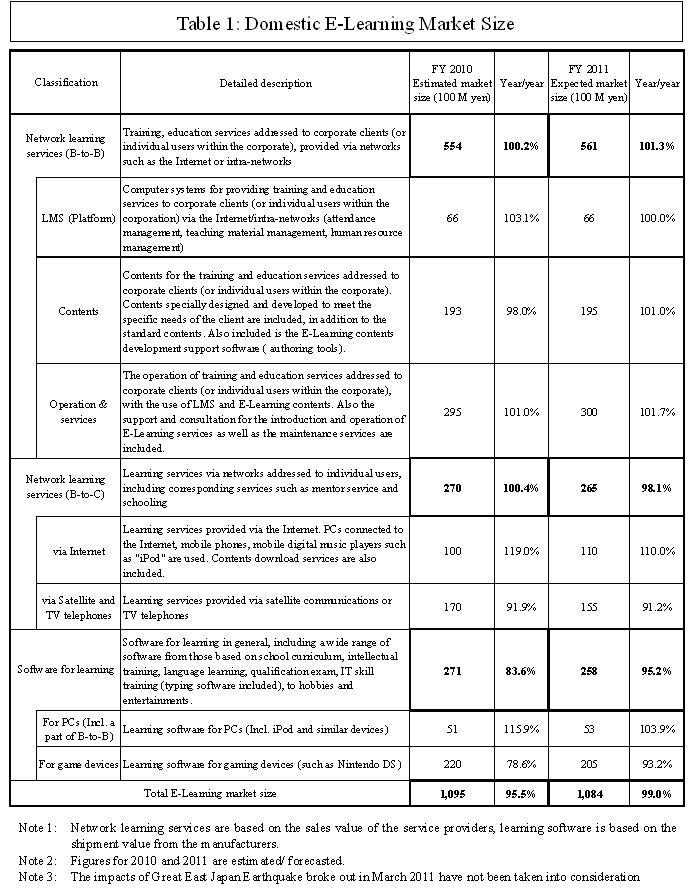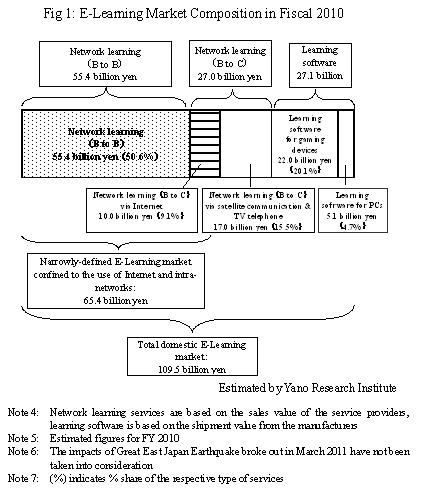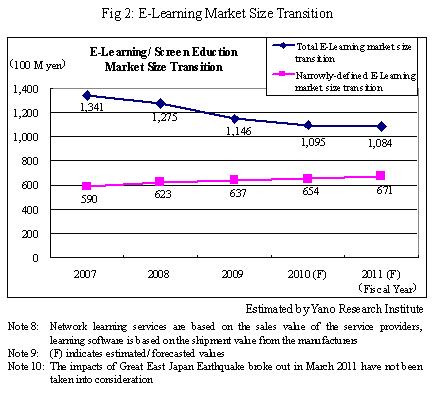E-Learning Market: Key Research Findings 2011
Internet learning services continued strong in fiscal 2010, with considerable increase of demands, especially, for online cram schools and family-use screen education services
Research Outline
Yano Research Institute has conducted a study on the E-Learning market as described below.
1. Research period: January to March 2011
Note: The impacts of Great East Japan Earthquake broke out in March 2011 have not been taken into consideration.
Note: The impacts of Great East Japan Earthquake broke out in March 2011 have not been taken into consideration.
2. Research targets:
E-Learning system developers, system integrators, system vendors, E-Learning contents developers and vendors, E-Learning training and lesson providers (cram schools, language schools, training providers), learning software developers and sellers, etc.
E-Learning system developers, system integrators, system vendors, E-Learning contents developers and vendors, E-Learning training and lesson providers (cram schools, language schools, training providers), learning software developers and sellers, etc.
3. Research methodologies:
Face-to-face interviews by YANO expert researchers, supplemented by telephone and e-mail follow-ups
< What is E-Learning market?>
E-Learning in this research includes, in addition to the “learning on the networked PCs”, methods of learning with mobile gaming devices, mobile phones (incl. smartphoes), mobile digital music players, learning software (incl. games), satellite communication services, and so forth.
The “domestic E-Learning market” in this report indicates the total of network learning service market (B to B), network learning service market (B to C), and learning software market, and the term, “narrowly-defined E-Learning market” is used to indicate a market of learning services provided via the Internet and intra-networks only.
Summary of Research Findings
◆ Key Findings
· The “narrowly-defined E-Learning market” confined with the use of the Internet and intra-networks continued to be strong in fiscal 2010. Especially, the screen education, such as foreign language lessons and cram school lectures attracted greater attentions.
The total market size of the “Domestic E-Learning market” in fiscal 2010 is estimated to be 109.5 billion yen, decreased by 4.5 percent compared to the previous year. However, the size of “narrowly-defined E-Learning market” confined to the services provided via the Internet and intra-networks is estimated to have continued strong and increased by 2.7 percent from the previous year to 65.4 billion yen, which can be attributable to the penetration of E-Learning into the corporate education programs and their cost-saving attitudes, in addition to the strong B-to-C market. Further, the provisions of training for “global business person” and screen education of foreign languages (online lessons, video contents for language learning, etc.) have attracted attentions.
· “Narrowly-defined E-Learning market” is expected to continue strong through fiscal 2011 as well, especially with remarkable growth of B-to-C services
The “narrowly-defined E-Learning market”, confined to the use of Internet and intra-networks, is expected to keep growing through fiscal 2011, with a slight increase by 2.6 percent from the previous year. Among the B-to-C services, the market size of the services provided via the Internet especially is expected to further increase by 10.0 percent from the previous year to 11.0 billion yen. The B-to-B service market, in the meantime, is expected to be 56.1 billion yen, with only a slight increase by 1.3 percent from the previous year.



Published Report
Report Title: E-Learning & Screen Education Business 2011
*The information provided in the "Research Summary" is what is as of the date of announcement and could be altered or renewed without any prior notice.